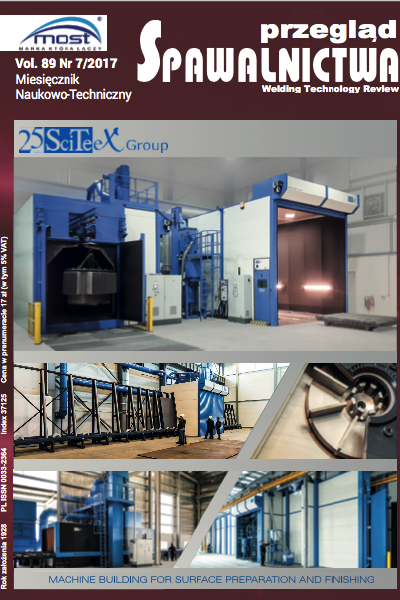The visualization of ultrasonic signals and inspection of defects in Magnetically Impelled Arc Butt welded elements
Main Article Content
Abstract
Non-destructive testing and functional tests are an integral part of the manufacturing process of components and constructions used in the automotive industry. The drive and transmission shafts joined by Magnetically Impelled Arc Butt (MIAB) welding process, continuously work under constant dynamic loads and must meet particularly high quality criteria. Currently, these tests involve the control of process parameters and destructive tests (including metallographic and functional tests crushing, twisting, petal test). The article presents an innovative in the automotive industry, including transmission driveshaft manufacturers, non-destructive, ultrasonic quality control methods of MIAB joints. The basic types of presentation of ultrasonic signals are discussed as well as how they are interpreted. Particular emphasis has been placed on the presentation of the capabilities and functionality of the developed application, which enables the visualization and acquisition of Non-destructive testing and functional tests are an integral part of the manufacturing process of components and constructions used in the automotive industry. The drive and transmission shafts joined by Magnetically Impelled Arc Butt (MIAB) welding process, continuously work under constant dynamic loads and must meet particularly high quality criteria. Currently, these tests involve the control of process parameters and destructive tests (including metallographic and functional tests crushing, twisting, petal test). The article presents an innovative in the automotive industry, including transmission driveshaft manufacturers, non-destructive, ultrasonic quality control methods of MIAB joints. The basic types of presentation of ultrasonic signals are discussed as well as how they are interpreted. Particular emphasis has been placed on the presentation of the capabilities and functionality of the developed application, which enables the visualization and acquisition of ultrasonic signals recorded during automated MIAB weld tests. signals recorded during automated MIAB weld tests.
in polish
Sposoby wizualizacji sygnałów ultradźwiękowych do wykrywania niezgodności w połączeniach zgrzewanych łukiem wirującym
Badania nieniszczące i testy funkcjonalne stanowią integralną część procesu produkcyjnego podzespołów i komponentów wykorzystywanych w przemyśle motoryzacyjnym. Półosie i wały napędowe zgrzewane łukiem wirującym (MIAB), będące elementami przeniesienia napędu są częściami, które podlegając ciągłym obciążeniom dynamicznym, muszą spełniać szczególnie wysokie kryteria jakościowe. Obecnie badania te polegają na kontroli parametrów procesu i badaniach niszczących (w tym badaniach metalogra cznych i testach funkcjonalnych zgniatanie, skręcanie, test płatkowy). W artykule przedstawiono nowatorską i innowacyjną w branży motoryzacyjnej, obejmującej producentów półosi i wałów napędowych nieniszczącą, ultradźwiękową metodę kontroli jakości połączeń zgrzewanych łukiem wirującym. Omówiono podstawowe rodzaje prezentacji sygnałów ultradźwiękowych oraz sposoby ich interpretacji. Szczególny nacisk położono na przedstawienie możliwości i funkcjonalności opracowanej autorskiej aplikacji, umożliwiającej wizualizację i akwizycję sygnałów ultradźwiękowych rejestrowanych podczas zauto- matyzowanego badania zgrzein wykonanych metodą MIAB.
Downloads
Article Details
Creative Commons CC BY 4.0 https://creativecommons.org/licenses/by/4.0/
Welding Technology Review (WTR) articles are published open access under a CC BY licence (Creative Commons Attribution 4.0 International licence). The CC BY licence is the most open licence available and considered the industry 'gold standard' for open access; it is also preferred by many funders. This licence allows readers to copy and redistribute the material in any medium or format, and to alter, transform, or build upon the material, including for commercial use, providing the original author is credited.
References
R. J. Brown: Non-destructive testing in industry, Non-Destructive Testing, vol. 6, nr 2, pp. 81-85, Apr. 1973.
Praca zbiorowa pod redakcją I. A. E. Agency: Non-destructive testing: A guidebook for industrial management and quality control personnel, International Atomic Energy Agency, IAEA-TCS-9, 1999.
W. Roye: Ultrasonic Testing of Spot Welds in the Automotive Industry, Krautkrämer GmbH & Co. oHG, nr SD 298, Listopad 1999.
M. Stachurski: Ultrasonic testing of thin-walled joints (3-7 mm in thickness), Advances in Manufacturing Science and Technology, vol. 29, no. 2, pp. 93-102, 2005.
M. Stachurski: Badania ultradźwiękowe połączeń cienkościennych (o grubości 3-7 mm), Biuletyn Instytutu Spawalnictwa w Gliwicach, vol. 49, nr 2, s. 57-61, 2005.
A. Bicz, W. Bicz, M. Korzeniowski, T. Piwowarczyk, A. Ambroziak: Ultrasonic Tests in the Analysis of the Quality of Tubular Welded Elements, Biuletyn Instytutu Spawalnictwa, nr 5, 2016.
J. Wiklund, U. Idermark: Ultrasonic transducers for testing of thin-walled tubes, Materialpruefung, vol. 18, pp. 280-284, 1976.
T. Piwowarczyk, A. Małachowska, P. Sokołowski: Tendencje rozwojowe zgrzewania łukiem wirującym w aspekcie zastosowań w przemyśle motoryzacyjnym, Przegląd Spawalnictwa, vol. 85, nr 6, 2013.
V. S. Kachinskiy, V. G. Krivenko, V. Y. Ignatenko: Magnetically Impelled Arc Butt Welding of Hollow and Solid Parts, Weld World, vol. 46, nr 78, pp. 49-56, 2002.
P. Kustroń, M. Korzeniowski, T. Piwowarczyk, P. Sokołowski: Application of Immersion Ultrasonic Testing For Non-Contact Quality Evaluation of Magnetically Impelled Arc Butt Welded Drive Shafts of Motor Vehicles, Advances in Automobile Engineering, vol. 2017, 2017.
